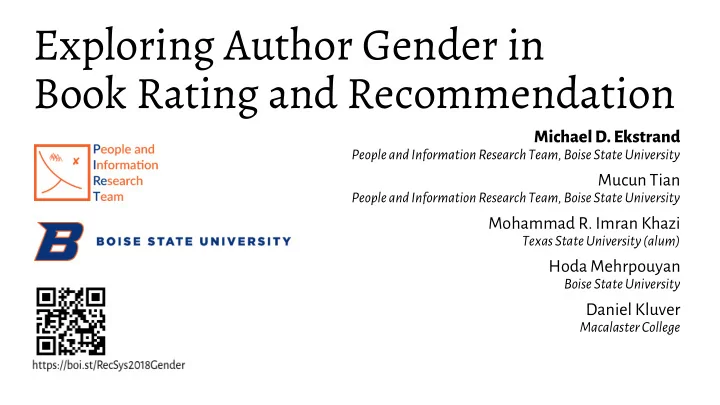

Exploring Author Gender in Book Rating and Recommendation Michael D. Ekstrand People and Information Research Team, Boise State University Mucun Tian People and Information Research Team, Boise State University Mohammad R. Imran Khazi Texas State University (alum) Hoda Mehrpouyan Boise State University Daniel Kluver MacalasterCollege
Diversity and Representation in Book Authorship 2
Source: Canadian Women in the Literary Arts. http://cwila.com/2015-cwila-count-methods-results/ 3
How do recommender systems interact with these efforts? 4
5 Hurdles by Ragnar Singsaas, used under CC-BY-SA 2.0. https://flic.kr/p/5jgjJP
Research Questions rq1 How are author genders distributed in cataloged books? rq2 How are author genders distributed in user book ratings? rq3 How are author genders distributed in recommendations? rq4 How do recommendations respond to user profiles? 6
Fairness Positioning Provider fairness (sort- of…) [Burke 2017] Calibrated fairness [Steck 2018] Descriptive , not normative 7
Data Ratings Books Authors BookCrossing OpenLibrary ISBN Name VIAF Amazon LoC 8
rq1 : Catalog Distribution Book Gender Book Gender (Known Gender) Female Male Ambiguous Unknown Unlinked Female Male 100% 100% 90% 90% 80% 80% 70% 70% 60% 60% 50% 50% 40% 40% 30% 30% 20% 20% 10% 10% 0% 0% LoC Amazon BX (Explicit) BX (All) LoC Amazon BX (Explicit) BX (All) 9
Recommender Experiment 1. Sample 1000 users (each rating 5 books with known author gender) 2. Measure user profile gender distribution ( rq2 ) 3. Generate 50 recommendations for each user 1. User-User 2. Item-Item 3. MF (Funk SVD) [didn’t personalize - ignore] 4. Poisson factorization 4. Compute recommendation list distribution ( rq3 ) 5. Compare recommendation lists to user profiles ( rq4 ) 10
Hierarchical Bayesian Model Data 𝑜 𝑣 𝑧 𝑣 𝑧 𝑣𝑏 𝑜 𝑣𝑏 ෨ Inferred 𝜄 𝑣 𝜗 𝑣𝑏 𝜄 𝑣𝑏 User Profile Rec List Regression Balance Balance (in log odds) (% Female) (% Female) 11
rq2 : Profile Distribution Mild tendency towards male authors (mean < 0.5) High variance in user profile composition Average is more balanced than book catalog 12
rq3 : Recommendation List Distribution Less variance than user profiles Average balance usually comparable Nearest-neighbor had most shift (U-U on explicit ratings, I-I on BX) 13
rq4 : Recommendation List Response Input balance propagates, though extent varies 14
Limitations • Rating data is extremely sparse • Algorithms didn’t perform particularly well • MF very non-personalized • Only considers binary gender identities • Working on statistical models to overcome that • Just a few algorithms Philosophy: expand knowledge with what we have, work on the limitations. 15
Conclusion Summary FutureWork • Users exhibit mild, diffuse • Better data tendency towards male authors • Better statistical model • User profiles more balanced than • More author features book catalog • More domains • Nearest-neighbor & PF algorithms • More algorithms propagated (some) user balance to recommendations • Study diversifying algorithms Questions? 16
Recommend
More recommend